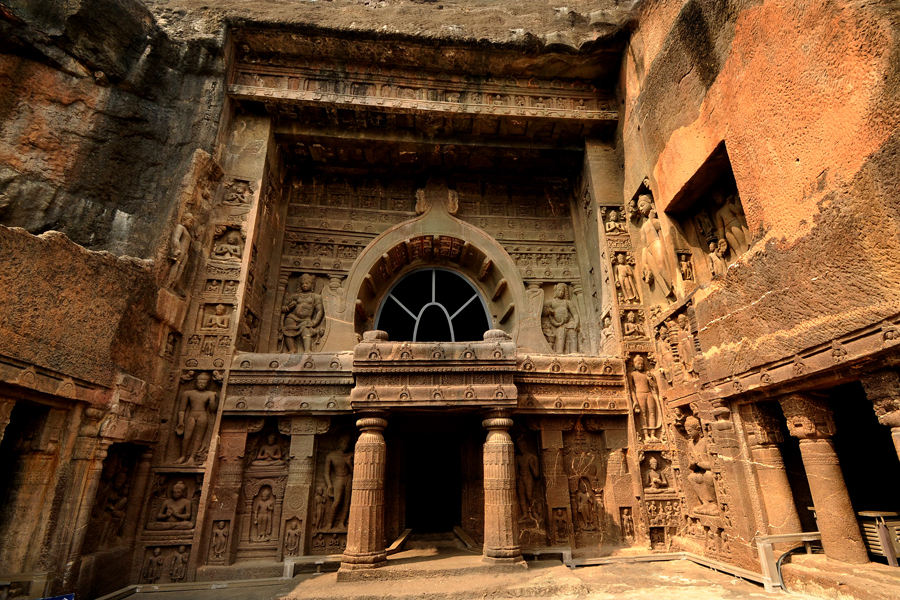The Ellora Caves, nestled in Maharashtra's Aurangabad district, represent one of humanity's most remarkable achievements in rock-cut architecture. This extraordinary complex, spanning over two kilometers along the Charanandri hills, encompasses 34 caves that stand as a testament to the harmonious coexistence of Buddhism, Hinduism, and Jainism in ancient India. The caves, excavated between the 6th and 12th centuries CE, showcase an unprecedented evolution of artistic and architectural styles that captivates visitors to this day.
The genesis of the Ellora Caves can be traced to the 6th century CE during the Kalachuri dynasty's reign. The earliest excavations began with Buddhist caves, characterized by their intricate designs and spiritual significance. As centuries passed, successive dynasties contributed to the complex's expansion, with the Rashtrakuta dynasty (8th to 10th centuries) creating many of the Hindu caves, including the magnificent Kailasa Temple. The final phase of construction occurred under the Yadava dynasty in the 11th and 12th centuries, who added the Jain caves, completing this remarkable testament to religious plurality.
The construction methodology employed at Ellora represents the pinnacle of ancient Indian engineering and artistic prowess. Artisans worked from top to bottom, carefully carving into the volcanic basalt rock face. This technique allowed for unprecedented precision in cave proportions and structural integrity. The crowning achievement of this architectural marvel is Cave 16, the Kailasa Temple, which stands as the world's largest monolithic structure. The creation of this temple required the removal of approximately 200,000 tons of rock, resulting in a massive complex that features intricate sculptures, towering pillars, and life-sized elephant statues.
The architectural and artistic elements within the caves reflect the evolution of religious thought and cultural expressions in ancient India. The Buddhist caves (1-12) chronicle the transition from Hinayana to Mahayana and Vajrayana Buddhism, featuring expansive prayer halls and detailed Buddhist iconography. The Hindu caves (13-29) showcase a rich tapestry of mythology through their sculptural programs, depicting various manifestations of Hindu deities and scenes from ancient epics. The Jain caves (30-34), characterized by their minimalist beauty and precise craftsmanship, embody the principles of simplicity and asceticism central to Jain philosophy.
The preservation techniques employed by the ancient artisans continue to intrigue modern researchers. Recent studies have revealed the use of an innovative mixture of cannabis with clay and lime plaster, which has contributed to the caves' remarkable longevity over 1,500 years. This ancient technology, combined with the natural durability of the basalt rock, has helped preserve the delicate sculptures and rare paintings that still adorn the cave walls, offering valuable insights into the sophisticated construction methods of ancient India.
The caves have drawn visitors throughout history, from medieval Indian rulers to European explorers. The Yadava kings of the 13th century left inscriptions commemorating their pilgrimages, while European travelers of the 17th and 18th centuries documented their awe at the caves' grandeur. The formal documentation of the caves began in 1819 when British officer John Smith brought them to wider attention, leading to systematic archaeological studies and conservation efforts that continue to this day.
The Ellora Caves maintain their significance as both a spiritual center and a cultural landmark. Their recognition as a UNESCO World Heritage Site in 1983 has enhanced their protection and global visibility. Today, the caves serve as a living museum of ancient Indian art and architecture, attracting thousands of visitors who come to witness the extraordinary achievements of ancient craftsmen and the profound spiritual heritage they represent.
The enduring legacy of the Ellora Caves lies not only in their architectural brilliance but also in their representation of India's syncretic cultural tradition. The peaceful coexistence of Buddhist, Hindu, and Jain caves within a single complex demonstrates the inclusive nature of ancient Indian society and its ability to embrace diverse religious and philosophical traditions. This remarkable site continues to inspire visitors with its timeless beauty and serves as a powerful reminder of humanity's capacity for artistic excellence and spiritual harmony.







